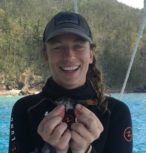DNA reveals the past and future of coral reefs
New DNA techniques are being used to understand how coral reacted to the end of the last ice age in order to better predict how they will cope with current changes to the climate. James Cook Univer

From 2005 to 2022, the main node of the ARC Centre of Excellence for Coral Reef Studies was headquartered at James Cook University in Townsville, Queensland (Australia)








Abstract: Multiple habitats in a tropical seascape are increasingly recognized as interconnected to one another. Mangroves, seagrass beds, and macroaglal beds are important components of a tropical seascape, and although they are unique and important in their own right, they also contribute to patterns and processes on coral reefs. In my PhD, I explore how non-reef habitats affect coral reef fishes in a highly connected seascape on Siquijor Island in the Philippines. Combining traditional reef fish and benthic habitat surveys with habitat mapping and spatial analysis of the seascape, I explore how fishes respond to habitat across multiple spatial scales. Firstly, I examine the relative importance of within-patch benthic habitat of coral reefs and adjacent non-reef habitats in the seascape on coral reef fish populations and assemblages. I then use DNA analysis to identify juvenile parrotfish species using non-reef habitats to investigate potential ontogenetic shifts. Finally, I utilise stable isotope analysis to explore diet and habitat use for important ‘herbivorous’ coral reef fish species (parrotfishes and rabbitfishes) to understand their diet and habitat use patterns. I found that coral reef fishes are influenced by non-reef habitats in the surrounding seascape, and that habitat within 500-m of coral reefs should be incorporated in species-habitat relationships. DNA analysis revealed an increase in non-reef habitat use for juvenile parrotfishes, and identified macroalgal habitat as a potentially important nursery habitat. I also found that habitat availability may be altering how species use non-reef habitats. My research highlights the importance of considering fish-habitat relationships at larger spatial scales, and underscores the importance of including non-reef habitats in future research.
New DNA techniques are being used to understand how coral reacted to the end of the last ice age in order to better predict how they will cope with current changes to the climate. James Cook Univer
A new study on the effects of climate change in five tropical countries has found fisheries are in more trouble than agriculture, and poor people are in the most danger. Distinguished Profess
James Cook University researchers have found brightly coloured fish are becoming increasingly rare as coral declines, with the phenomenon likely to get worse in the future. Christopher Hemingson, a
Researchers working with stakeholders in the Great Barrier Reef region have come up with ideas on how groups responsible for looking after the reef can operate more effectively when the next bleaching
Abstract: As marine species adapt to climate change, their heat tolerance will likely be under strong selection. Individual variation in heat tolerance and its heritability underpin the potential fo
Abstract: The Reef Ecology Lab in KAUST’s Red Sea Research Center explores many aspects of movement ecology of marine organisms, ranging from adult migrations to intergenerational larval dispersal
Abstract: Macroalgal meadows are a prominent, yet often maligned component of the tropical seascape. Our work at Ningaloo reef in WA demonstrate that canopy forming macroalgae provide habitat for ad
Abstract: Sharks are generally perceived as strong and fearsome animals. With fossils dating back at least 420 million years, sharks are not only majestic top predators but they also outlived dinosa
Abstract: Connectivity plays a vital role in many ecosystems through its effects on fundamental ecological and evolutionary processes. Its consequences for populations and metapopulations have been
Abstract: Evolution of many eukaryotic organisms is affected by interactions with microbes. Microbial symbioses can ultimately reflect host’s diet, habitat range, and even body shape. However, how
Abstract: The past few years have seen unprecedented coral bleaching and mortality on the Great Barrier Reef (GBR) but the consequences of this on biodiversity are not yet known. This talk will expl